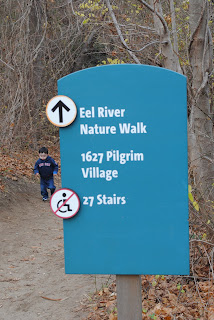As I left the Visitor Center the path forks, right side to The Wampanoags , left side to the English Village. Since the Wampanoags have been here for the better part of 12,000 years, living in harmony with the land and the seasons, it seemed that the story should start there, not the Village.
It occurs to me that if the English had arrived today that there could be an entirely different outcome. What if the Wampanoag had immigration laws? Would the “Border Patrol” put the colonists back on the boat and send them home? Would they detain them in a prison for “illegal entry”? Would the subsequent wars waged have been considered treason? What if we looked at the actions of both sides back in the 1600’s and put it in a modern context? How might that change our perceptions’ of what happened?
But those musings are better saved for another time. Right now I am wandering down the woodland path and approaching Hobbamock’s Homesite.
The Homesite is a re-created 17th century dwelling and planting area. The staff at the Homesite are all Native Americans. Although they are dressed in traditional Native American garb from that time period, they are not role playing. They are demonstrating the ancient skills and tools of their ancestors and explaining the life from a modern perspective.
The Homesite is a 3 season home. An extended family lived on 2 or 3 acres of land during the spring, summer and fall months.
When winter arrived, the families traveled to larger inland villages.
Before the arrival of the “White Man” there were approximately 50,000 Wampanoag in 67 different villages throughout their territory. But once the Colonists arrived they brought European diseases that the Native Americans had no resistance to. In two years from 1616-1618 a devastating plague brought by the Europeans swept though the Wampanoag causing thousands of deaths.
Thousands more were killed or sold into slavery during King Philip’s War (1675). Today there are only 4-5 thousand Wampanoag left from the once mighty nation.
There was a real division of labor in Wampanoag society. Wampanoag women grew and processed the 3 sisters, corn, beans and squash. They also cured the animal skins and made the clothing for the family.
The men built the Wetuash (houses) which were dome shaped and covered with bark and cattail reed mats. They also made dugout canoes called mishoons by burning and scraping oak, pine and chestnut logs.
The Wampanoag like many Native Peoples rely on oral tradition to keep their culture alive from generation to generation. Stories are told and retold, never changing. At the Homesite you can sit by a fire in the wetu (house) and listen to the Native staff share stories of their culture and history. I will have to try to experience that on another trip as there was a line around the wetu of children waiting to get in. I browsed the area for awhile but the line never seemed to shrink. As fast as one group entered another joined the line.
After a time the Wampanoag language began to die out with only a few native speakers remaining but like many other cultures, a new pride in heritage has created a climate that encouraged the recovery and teaching of language and traditions. A similar revival in the Hawaiian culture has saved much of those traditions as well.
Children in the Wampanoag culture are considered gifts from the gods and not expected to do “chores” although they may help protect the family’s corn crop by keeping watch for foraging animals.
The Homesite sits on the edge of the Eel River. This location revealed itself as a true homesite by the shell middens found and arrowheads which show up when turning the soil for a garden or after a strong rain.
One thing was the same for both the Wampanoag and the Colonists. Acquiring, preparing and preserving food was a top priority. Men were responsible for hunting, trapping and fishing but once the food was brought home, it was the women who preserved and prepared it. Women and children also gathered shellfish and berries.
It was time to move on to the 1627 English Village. I followed the Eel River Boardwalk to the 27 stairs and the Village beyond. I like the boardwalk. It makes the walking easy but it also allows you to observe sweeping vistas over the marshy pond that is located at the mouth of the Eel. Birds and turtles are a common sight. Today there were two graceful white swans swimming on the far side of the pond.















2 comments:
Love the pictures, brings back memories. You do such a good job.
Thank you. I'm glad you keep following and commenting
Post a Comment